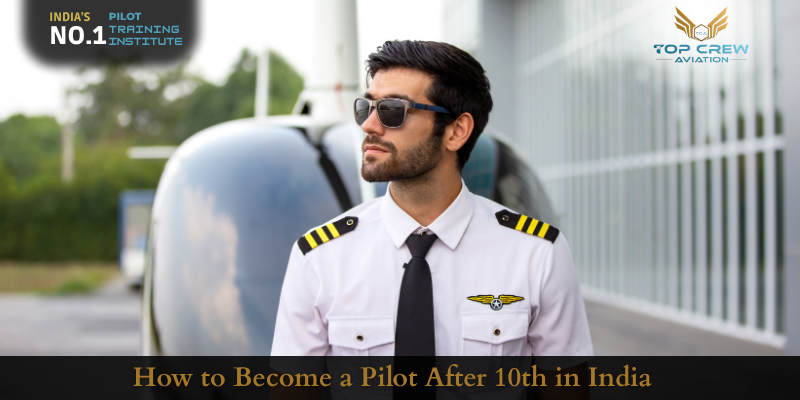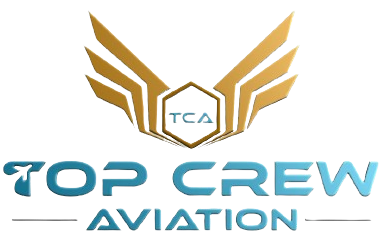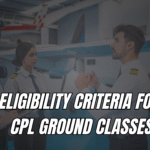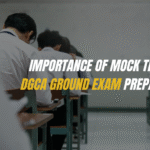
Have you ever looked up at the sky and imagined yourself flying an aircraft? If the idea of becoming a pilot excites you, then you’ll be happy to know that your dream can begin much earlier than you might think. While many believe that pilot training only starts after completing Class 12, the truth is, you can start preparing for a flying career right after your 10th Class.
This blog is a complete guide for students who want to know how to become a pilot after 10th in India. It covers everything — from basic eligibility and required qualifications to the types of pilot courses, fees, duration, medical requirements, and top flying schools like Top Crew Aviation. If you’re serious about an aviation career, read this blog till the end.
Can You Become a Pilot After 10th Class?
Yes, you can start preparing to become a pilot after the 10th Class in India. Still, with one important condition — you cannot get a full Commercial Pilot License (CPL) until you complete your 12th standard with Physics and Mathematics.
However, many flying schools offer foundation courses, Student Pilot License (SPL) programs, and pre-aviation training that can be joined right after the 10th. These programs help you get an early head start in the aviation industry. By starting early, you’ll be more confident, better prepared for exams, and ready to begin flying as soon as you finish your 12th.
Step-by-Step Process to Become a Pilot After 10th in India
Becoming a pilot is a journey that includes both academic studies and practical flying experience. Below is a detailed step-by-step roadmap for students who have just completed their 10th:
Step 1: Pass Class 10 from a Recognised Board
The very first step is to pass your 10th Class with any stream (Science, Commerce, or Arts). At this point, your marks or subjects are not a barrier — but they will become important when you move on to the following stages of training.
Step 2: Choose Science Stream in 11th and 12th (With Physics & Mathematics)
After completing 10th, enrol in the Science stream with Physics and Mathematics in 11th and 12th. This is a mandatory requirement by the DGCA (Directorate General of Civil Aviation) for obtaining a Commercial Pilot License (CPL).
- If you didn’t take Physics or Math in 12th, you can later appear for those subjects through NIOS (National Institute of Open Schooling).
- Minimum marks: At least 50% aggregate in Physics and Mathematics.
Step 3: Undergo DGCA Medical Examinations (Class 2 & Class 1)
Before you begin flying, your medical fitness must be certified. There are two types of DGCA medical tests:
- Class 2 Medical (initial medical test for SPL and PPL)
- Class 1 Medical (mandatory for CPL)
Only DGCA-approved doctors can conduct these tests. These tests check your eyesight, hearing, blood pressure, and overall health to ensure you’re physically fit to fly an aircraft.
Tip: Get your Class 2 medical done after the 10th so you can plan early.
Step 4: Join a Foundation Aviation Course (After 10th)
Once your medicals are clear, you can enrol in a foundation or pre-aviation course at a flying institute. These programs teach you:
- Basics of aerodynamics
- Air regulations and meteorology
- Aviation English and communication
- Introduction to navigation and radio telephony
Such training builds your base before you begin actual flying. Many students who start after 10th are more confident during DGCA ground school exams later.
Top Crew Aviation in Jaipur offers one of the best pilot foundation programs after 10th. Their expert trainers and DGCA-oriented syllabus make them a top choice in India.
Step 5: Apply for Student Pilot License (SPL)
Once you turn 16 years old and pass the basic written and oral tests, you can apply for an SPL — your first official flying license. It allows you to start initial flight training under supervision.
Requirements:
- Age: 16 years minimum
- Class 2 Medical Certificate
- Basic written exam (aviation theory and air regulations)
- Interview and assessment
Step 6: Clear Class 12 with PCM and Focus on Ground School Subjects
Now, focus on completing your 12th with good marks in Physics, Chemistry, and Mathematics. Simultaneously, you can begin studying DGCA ground subjects:
- Air Navigation
- Aviation Meteorology
- Technical General & Technical Specific
- Air Regulations
- Radio Telephony (RTR)
These subjects are part of the DGCA CPL syllabus and are tested in written exams that you must pass before flying training.
Step 7: Enrol in a DGCA-Approved Flying School for CPL
Once you meet the above qualifications, you can officially join a DGCA-approved flying school in India for Commercial Pilot License (CPL) training.
CPL Training Includes:
- 200 hours of total flying
- Simulator training
- Solo flights
- Cross-country flying
- Night and instrument flying
During this stage, you’ll also pass all six DGCA theoretical exams and your Class 1 medical (if not done earlier).
Educational Qualifications Required
Here’s a summary of the educational path to becoming a pilot:
| Qualification | Details |
| Minimum Education | 10th pass to begin foundation program |
| CPL Eligibility | 10+2 with Physics and Mathematics (50% min) |
| Alternate Path | Clear PCM from NIOS if missed in 12th |
| English Language Proficiency | Must speak, write, and understand English fluently |
Types of Pilot Licenses in India
- SPL (Student Pilot License) – For basic flying lessons under supervision.
- PPL (Private Pilot License) – Allows non-commercial flying for personal use.
- CPL (Commercial Pilot License) – Required to work as a paid airline pilot.
- ATPL (Airline Transport Pilot License) – For senior airline captain roles.
Fees & Duration for Pilot Training After 10th
Becoming a pilot is a rewarding career — but it also requires significant financial investment. Here’s a detailed breakdown:
| Course | Duration | Estimated Cost |
| Foundation Course | 6 months – 1 year | ₹2 – ₹4 lakhs |
| DGCA Ground School | 6–8 months | ₹2 – ₹3 lakhs |
| Flying Training | 18–24 months | ₹30 – ₹40 lakhs |
| Total Pilot Training Cost | 2.5 – 3 years total | ₹35 – ₹45 lakhs approx |
Tip: Look for education loans, scholarships, or EMI options offered by flying schools.
Career Opportunities After Becoming a Pilot
Once you have your Commercial Pilot License (CPL), you can apply for various roles:
Jobs in the Aviation Industry:
- First Officer (Co-Pilot) in commercial airlines
- Private Jet Pilot
- Cargo Pilot
- Charter Services
- Corporate Jet Pilot
Other Career Options:
- Flight Instructor
- Simulator Trainer
- Aerial Survey Pilot
- Government Aviation Departments (e.g., BSF, Coast Guard)
The aviation industry in India is growing fast, and with new airlines and routes, there’s a high demand for skilled pilots.
Top Flying Schools in India
Here are some of the top DGCA-approved pilot training institutes:
- Top Crew Aviation – Jaipur, Rajasthan & Delhi
- Indira Gandhi Institute of Aeronautics (Chandigarh)
- Madhya Pradesh Flying Club (Indore)
- Capt. Sahil Khurana Aviation Academy
- Flytech Aviation Academy (Hyderabad)
- Rajiv Gandhi Aviation Academy (Hyderabad)
Top Crew Aviation is widely recognised for its top-tier facilities, expert trainers, DGCA exam success rate, and transparent fee structure. Visit www.topcrewaviation.com for more info.
Advantages of Starting Pilot Training After 10th
- More preparation time before CPL
- Strong foundation in aviation concepts
- Familiarity with DGCA exams and subjects
- Early exposure to the aviation environment
- Higher confidence and discipline
- Career-focused guidance from an early age
Final Words – Ready to Take Off?
If your dream is to become a professional pilot, don’t wait. Starting after the 10th gives you a clear head start. By joining a foundation course, preparing for DGCA requirements, and focusing on academics, you’ll be ready for CPL as soon as you finish 12th.
Let Top Crew Aviation guide you from classroom to cockpit. With experienced instructors, real aircraft training, and complete DGCA exam support, Top Crew is one of the best aviation academies in India for students starting right after 10th.
Suggestion URL :
Frequently Asked Questions
No FAQs found.



